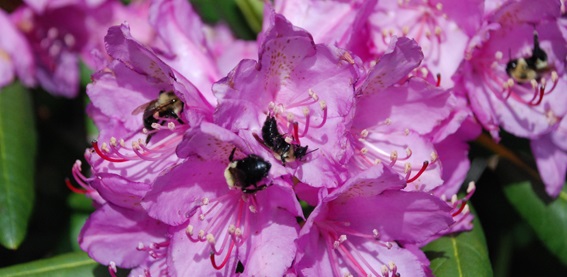
Scientists at Sussex University have discovered that bees are exposed to a 'chemical cocktail' when feeding from wildflowers growing next to neonicotinoid treated crops in UK farmland. These chemical cocktails could make the impact of neonicotinoids up to 1000 times more potent than previously realised, according to new research.
One in 10 species of Europe's wild bees is facing extinction, and neonicotinoid insecticides are increasingly seen as contributing to these declines. In addition to neonicotinoids, farmers may spray some non-organic crops a dozen or more times while they are growing, with anything up to 23 different chemicals.
New research by Sussex University and supported by the Soil Association reveals that pollinators consuming pollen from these crops or from nearby wildflowers will ingest a cocktail of fungicides and insecticides. A prior study suggests these fungicides could act synergistically, making the insecticides up to 1000 times more deadly than they are on their own.
To combat bee decline, the Government’s Pollinator Strategy has focused on creating ‘safe havens’ for bees by increasing flower habitats next to fields – yet this research shows these flowers may be laden with dangerous chemicals.
Peter Melchett, Policy Director of the Soil Association said: “These findings are shocking. Neonicotinoids are supposedly highly targeted insecticides yet the researchers have found that they are turning up in the pollen of poppies, blackberries and hawthorn blossom in hedges, at levels that on their own are enough to cause harm to bees. Worse still, they are present along with a whole cocktail of chemicals, some of which could increase the toxicity of neonicotinoids up to 1000 times.
“The UK government must act. Until now, the government’s main solution to the bee crisis is to pay farmers a small chunk of the £900 million Common Agricultural Policy (CAP) money, available to help wildlife, to create flower rich habitat next to crops. Yet this research suggests that these supposedly safe havens for bees are actually potentially dangerous chemical cocktail bars.
“These flower margins must be protected with a full ban on neonicotinoids; the current EU ban is only partial, and in the UK mainly applies to just one crop– oilseed rape. Neonicotinoids are still used on other crops, for example on over 25% of all UK cereals. Neonicotinoids will be poisoning the field margins of many of these crops. We also want to see the government finally setting out a strategy for reducing pesticide use in farmland – as is required by EU law. This has always been the gaping hole in the government’s strategy to save our bees”.
Dave Goulson, Professor of Biology at the University of Sussex, and one of the authors of the paper, said: “It is clear that insects visiting wildflowers in field margins are chronically exposed to a cocktail of chemicals. The effects that this has on their health have never been studied, and there is an urgent need to do so. In the meantime, the precautionary principle would suggest that we should take steps to reduce this exposure as much as possible.”
Dr Christopher Connolly, School of Medicine, University of Dundee, who was not involved in the research, commented: “Validating semi-field studies on neonicotinoids (artificial provision of pesticide) requires confirmation that bees do actually get exposed to these levels of pesticide in the field where multiple sources of pollen and nectar exist. This study provides such a bridge to validate previous studies. Furthermore, of the 20 pesticides examined, most OSR pollen samples contained 7-12 different pesticides, whilst pollen gathered by honeybees and bumblebees contained 2-10 pesticides.
This does not represent the full pesticide load, only a reflection on the few examined. Pesticide levels in pollen gathered in urban areas were much lower, but still contaminated, demonstrating both the value of the urban environment and need to minimise garden pesticide use. The work by David et al is very important as, although in Europe, farmers are legally obliged to keep pesticide use records (EC No. 1107/2009), the data are not collected and so scientists have no access to local cocktail use. Therefore, studies like this should help governments realise the potential importance of gathering this information.”
The wild flowers found by researchers to be contaminated by neonicotinoids and other toxic sprays included: Creeping Buttercup, White Campion, Scented Mayweed, Hogweed, Poppy, Wild Rose, Burnet Saxifrage and Fool's Parsley.
